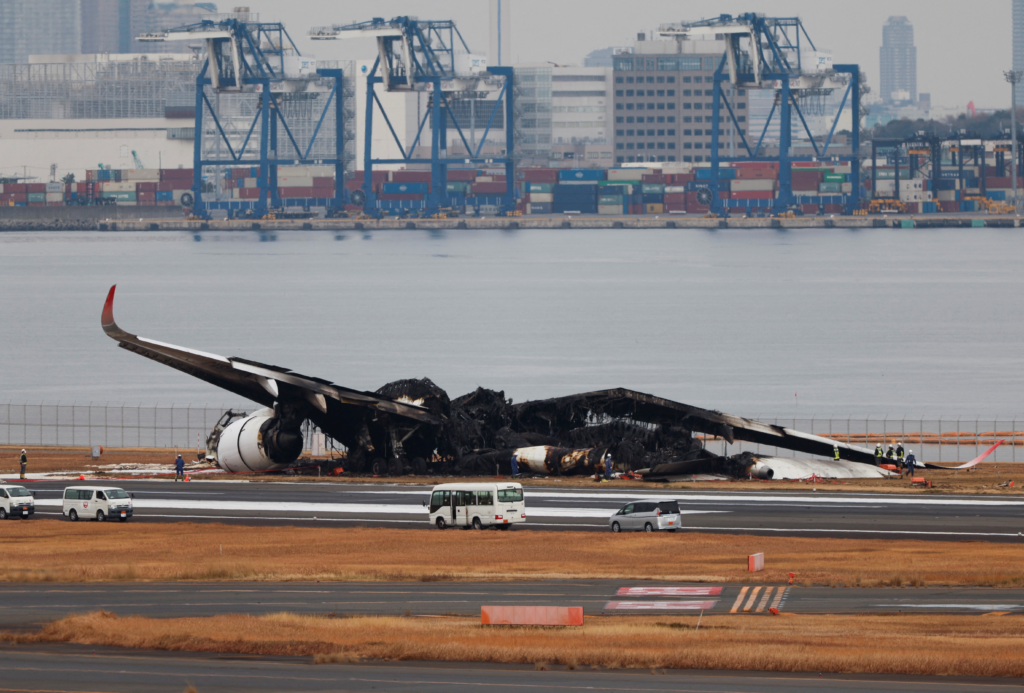TOKYO- The pilots on the Japan Airlines (JL) Airbus A350, which caught fire after all 379 passengers and crew had evacuated, had no “visual contact” with the coastguard aircraft involved in the crash, as stated by the airline on Thursday.
Additionally, the three pilots couldn’t initially see the fire from the cockpit and were alerted to it by the cabin crew, according to a JAL spokesperson.

Japan Airlines A350 Crash and Rescue
The incident occurred when the airliner collided with a coast guard plane after landing at Tokyo’s Haneda Airport on Tuesday evening. Tragically, all but one of the six people on the smaller aircraft lost their lives.
A significant blaze engulfed the airliner, reducing it to a charred wreckage on the tarmac.
However, the pilots asserted that they had no “visual contact” with the other plane, although one of them did notice “an object” just before the impact, according to JAL.
The spokesman mentioned, “After the plane landed and around the time when the front wheels touched or were about to touch the ground — during those few seconds, they said they felt an impact.”
Simultaneously, the chief flight attendant, one of nine onboard, informed the cockpit about the fire, necessitating permission to open the emergency exits, as reported by broadcaster NHK. By this point, the cabin was filling with smoke, growing hotter, with infants crying and passengers pleading for the doors to be opened, as depicted in the footage.
Although there were eight emergency exits available, the evacuation commenced from two slides at the front of the plane due to the presence of the fire.
The crew took matters into their own hands and opened a third exit at the rear because the malfunctioning intercom system prevented them from requesting the cockpit to do so.
The complete evacuation of the plane took 18 minutes, with the pilot being the last person to disembark onto the tarmac at 6:05 pm. Shortly after, the aircraft turned into an inferno, prompting dozens of fire engines to attempt to extinguish the blaze. This firefighting process ultimately extended for eight hours.

Under Investigation by Int’l Agencies
“Frankly, I didn’t think we would make it,” expressed another woman in an interview with broadcaster NHK.
Ultimately, only two passengers suffered physical injuries, such as bruises or twisted limbs, according to JAL. Terence Fan, an airline industry expert from Singapore Management University, remarked, “Passengers seemed to have followed instructions in a textbook manner,” in a statement to AFP.
As of Thursday, investigators from Japan, France, Britain, and Canada were examining the crash, and the charred remnants of the two planes were still scattered on one of Haneda’s four runways.
The flight and voice recorders from the Coast Guard plane have been located, along with the flight recorder from the passenger jet, although its voice recorder is still missing.
The transportation ministry has disclosed transcripts of the flight controllers’ communications, indicating their approval for the JAL flight’s landing. However, the transcripts reveal that the Coast Guard plane was instructed to proceed to a location near the runway.
Previously, NHK had reported that the pilot, Genki Miyamoto, aged 39, mentioned immediately after the accident that he had obtained permission to take off.

US$100+ Million Loss
JAL anticipates a damage cost of 15 billion yen (Approx US$100 million) for the destroyed plane, which is expected to be covered by insurance. The airline is currently evaluating the impact on company earnings.
Japan has not encountered a significant commercial air crash for many decades.
In 1985, a JAL jumbo jet en route from Tokyo to Osaka tragically crashed, resulting in the loss of 520 passengers and crew—a harrowing incident marking one of the deadliest crashes involving a single flight.
The most catastrophic civil aviation disaster worldwide occurred on the ground in 1977 when two Boeing 747s collided at Los Rodeos Airport on the Spanish island of Tenerife, claiming the lives of 583 people.
Stay tuned with us. Further, follow us on social media for the latest updates.
Join us on Telegram Group for the Latest Aviation Updates. Subsequently, follow us on Google News.

